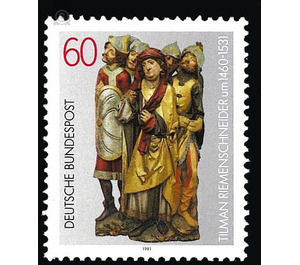450th anniversary of death of Tillmann Riemenschneider - Germany / Federal Republic of Germany 1981 - 60 Pfennig
Theme: Art & Culture
| Country | Germany / Federal Republic of Germany |
| Issue Date | 1981 |
| Face Value | 60.00 |
| Color | multi-colored grey |
| Perforation | K 14 |
| Printing Type | Six-color offset printing |
| Stamp Type | Postage stamp |
| Item Type | Stamp |
| Chronological Issue Number | 972 |
| Chronological Chapter | GER-BRD |
| SID | 28851 |
| In 53 Wishlists | |
The work of the "Bildschnitzers von Würzburg," Tilman Riemenschneider, decides in a late flowering the rich pictorial tradition of the Middle Ages in Mainfranken. In Osterode in the Harz, Til Riemenschneider, the son of a mint master, was born in Heiligenstadt on the Eichsfeld around 1460. He had lived through his childhood. Already the approximately eighteen year old we find for the first time in Würzburg. Riemenschneider was in these years on the wanderings of the journeyman. He presumably came over Erfurt, and via Würzburg his path first led him further to the Upper Rhine and the sculptor's workshops in Schwaben, above all to Ulm. The encounter with the softer and more relaxed sculpture of Schwaben has given the young sculptor a very personal style. After a few years, Tilman Riemenschneider returned to Würzburg. In 1483 he was admitted to the guild of painters and sculptors of the city. The marriage with the widow of a long-established goldsmith gave Riemenschneider here in 1485 civil rights and masters, condition for the establishment of its own workshop. The Master's art quickly found applause and supporters. Year after year, his works, executed in wood and stone with equal mastery, go out into the towns and villages of Mainfranken and the Taubertal. Since 1493 the figures of Adam and Eve decorate the Marienkapelle in Würzburg, today the center of the large Riemenschneider collection of the Mainfränkisches Museum in Würzburg. The memorial of the old Prince-Bishop Rudolf von Scherenberg is the grave monument in Würzburg Cathedral, worked 1496-1499 by Riemenschneider. Riemenschneider created the splendid imperial tomb for the cathedral in Bamberg in 1499-1513. The Franconian towns - among them Münnerstadt (Magdalena Altar), Rothenburg o. D. T. (et al., St. Blood Altar), Creglingen (Marienaltar) and Windsheim ("Twelve-messenger altar" - now Museum Heidelberg) - entrust Riemenschneider with extensive altarpieces. Riemenschneider's last work, the silent, monumental stone tablet depicting the Lamentation of Christ, can be found in the church of Maidbronn near Würzburg. His style, which lives on a spiritual mildness and a quiet fineness, has dominated the Franconian land around Main and Tauber for almost five decades. The growing esteem of the artist corresponded to the master's appointment to civil honorary offices. Since 1504 we find Riemenschneider in the city council. He was repeatedly called to the Upper Council; Coronation meant the election as mayor for the year 1520/21. As a councilor also Riemenschneider was torn in 1525 in the vortex of the peasant war. His opinion on the cause of the insurgents influenced the Council's opposition to the princely demand for the use of citizenship against the advancing power of the peasants. So was Riemenschneider among the councilors of the episcopal city, who had to endure prison, terror and torture. Released from his honorary posts, and not only impaired in his bourgeois existence by the partial expropriation of his fortune, there was silence about the aging master, who died on July 7, 1531. (Text: Hanswernfried Muth, Mainfränkisches Museum, Würzburg)


